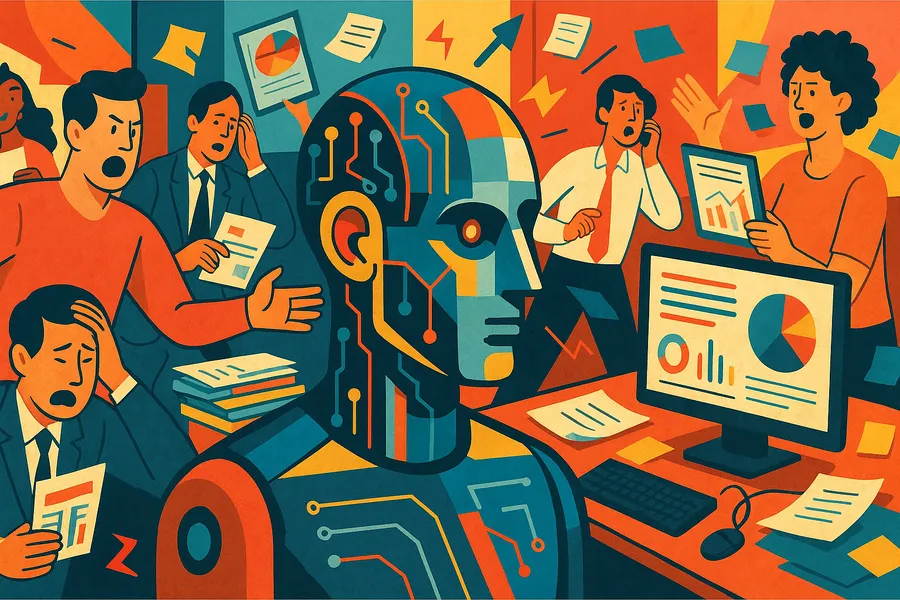A couple of years ago, when we focused on artificial intelligence services at Redstone Labs, we knew the potential was enormous, but we weren’t prepared for the real implementation challenges in actual organizational contexts. To be honest, we’ve had to face more resistance, confusion, and skepticism than I had imagined.
The Initial Challenge
A year ago, we started a project with a company that was in the middle of an ambitious digital transformation process. They had the vision to leverage artificial intelligence to accelerate their growth, improve operational efficiency and enhance customer service.
However, we quickly noticed several important challenges.
Expectations vs Reality
At the start of the project, there was great excitement and high expectations about the immediate potential of artificial intelligence. They firmly believed that by connecting some APIs, like ChatGPT, AI would automatically start generating valuable and noticeable results. However, within weeks, the feeling of optimism turned into deep disappointment.
We discovered that no one on the team knew how to effectively interact with AI. The prompts were imprecise, too general, and ambiguous.
This generated superficial, unhelpful, or even incorrect responses. Frustration began to dominate the atmosphere, with team members openly questioning the real utility of AI.
The Data Problem
As we dug deeper, we identified another critical challenge: the company had accumulated huge volumes of data, scattered and disorganized across multiple internal platforms. They initially believed they could feed all this information to AI and automatically obtain valuable insights.
It was a hard blow to explain to them that they first needed to govern their data, which meant organizing it, cleaning it, labeling it, and ensuring minimum quality standards.
Resistance to Methodological Change
The situation became even more complicated when we proposed implementing specific methodologies for AI projects, adapted to shorter iteration cycles and continuous experimentation. The team was already familiar with Agile and Scrum, and the mere idea of introducing another methodological framework generated immediate resistance.
The 5 Key Learnings
These experiences taught us a lot about the real challenges of integrating AI into organizations. Although each situation has its particularities, there are 5 key learnings that can serve any company:
1. Data Governance First
AI depends directly on data quality. It’s essential to properly organize, clean, and label data before integrating it with AI solutions. Additionally, it requires establishing constant audit processes, dedicated roles, and ensuring compliance with internal and external regulations regarding privacy and security.
2. Effective Prompts
Learning to formulate clear and specific questions for AI is crucial. This includes training the team in tool selection, techniques for defining precise contexts, properly interpreting and evaluating results, and sharing best practices internally to maximize the value obtained.
3. Cultural Change
AI integration implies a profound change in how the company works and thinking about the best way to leverage AI as a first option. Natural resistance to change must be actively managed through clear communication, continuous training, and employee empowerment at all stages of the process.
4. AI-Specific Methodologies
Traditional agile methodologies need adaptations when it comes to AI. It’s important to adopt approaches that allow for rapid iterations, quick prototyping, frequent user validation, and agile adjustments based on results.
5. Realistic Expectations
Although AI’s potential is immense, it’s not magic. It’s common to find an exaggerated and simplified narrative on social media that promises quick and easy results by just “connecting a couple of tools.” This hype can create false expectations, generating frustration when reality doesn’t match what was promised. It’s key to conduct well-structured pilot projects, establish clear objectives, and advance step by step. Maintaining realistic expectations avoids frustrations, facilitates progressive adaptation, and allows for genuine appreciation of AI’s real benefits.
—
Implementing AI in Chilean companies confirmed to us that the challenge is both human and technological. The most valuable thing we learned is that it’s not just about technology, but about building trust, unlearning old practices, and preparing people for a new paradigm.
A successful implementation not only changes processes but changes mindsets. When this happens, AI stops being a distant promise and becomes a real, everyday ally for solving problems, freeing up time, improving decisions, and raising work quality.
The path can be difficult, but it’s also deeply inspiring. Seeing a team move from skepticism to enthusiasm, from doubt to ownership, is one of the most rewarding experiences.
Are you struggling to implement AI within your company?
Let’s talk. At Redstone Labs, we specialize in supporting you in this transformation process.
